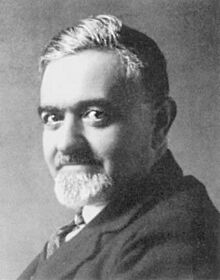Giuseppe Vitali facts for kids
Quick facts for kids
Giuseppe Vitali
|
|
|---|---|
 |
|
| Born | 26 August 1875 Ravenna, Italy
|
| Died | 29 February 1932 (aged 56) Bologna, Italy
|
| Nationality | Italian |
| Scientific career | |
| Fields | Mathematics |
Giuseppe Vitali (born August 26, 1875 – died February 29, 1932) was an Italian mathematician. He worked on many different parts of mathematical analysis, which is a branch of mathematics.
He is famous for several ideas in math that are named after him. One of the most well-known is the Vitali set. He was the first to show an example of a non-measurable group of real numbers. This means it's a set of numbers that cannot be easily measured or assigned a "size" in a standard way.
About Giuseppe Vitali
Giuseppe Vitali was the oldest of five children. His father, Domenico Vitali, worked for a railway company in Ravenna, Italy. His mother, Zenobia Casadio, stayed home to care for the children.
Giuseppe finished his first years of school in Ravenna in 1886. Then, he spent three years at a local high school called Ginnasio Comunale. His grades in the final exams of 1889 were about average.
He continued his high school studies at the Dante Alighieri High School in Ravenna. There, his math teacher, Giuseppe Nonni, quickly saw that young Giuseppe had a lot of talent. In 1895, his teacher wrote to Giuseppe's father. He asked that Giuseppe be allowed to study mathematics further.
Giuseppe Vitali then became a student at the Scuola Normale Superiore in Pisa. He later graduated from the University of Pisa in 1899. He worked as an assistant for two years. After that, he left the university world for a while.
From 1901 to 1922, he taught in high schools. He taught first in Sassari, then in Voghera. From 1904, he taught at the Classical High School Christopher Columbus in Genoa. During these years, he was also involved in politics. He was a member of the Italian Socialist Party. This group was later forced to break up by a political movement called Fascists in 1922. After this, he focused almost entirely on his math studies.
In 1923, he became a professor of calculus at the University of Modena and Reggio Emilia. He also taught at the Universities of Padua (from 1924 to 1925) and Bologna (starting in 1930). He was asked to speak at a big meeting for mathematicians. This was the International Congress of Mathematicians held in Bologna in September 1928. He gave a talk called Unexpected relationships of some branches of mathematics.
Later in his life, starting in 1926, Giuseppe Vitali became very ill. He even lost the use of one arm, which made writing difficult. Even with this challenge, about half of his research papers were written in the last four years of his life.
On February 29, 1932, he gave a lecture at the University of Bologna. He was walking and talking with another mathematician, Ettore Bortolotti, when he suddenly collapsed and died on the street. He was 56 years old.
Giuseppe Vitali published a lot of important math work during his career. His most important work was done in the early 1900s. He was honored for his work. He was chosen to be a member of the Academy of Sciences of Turin in 1928. In 1930, he joined the Accademia Nazionale dei Lincei. In 1931, he became a member of the Academy of Bologna.
Vitali's Math Discoveries
Giuseppe Vitali made many important contributions to mathematics.
In 1905, Vitali was the first to show an example of a non-measurable group of real numbers. This is known as the Vitali set. His covering theorem is a very important idea in measure theory. Measure theory is a part of math that deals with assigning a "size" or "measure" to sets of numbers.
He also proved several theorems about how sequences of functions behave. These include measurable and holomorphic functions. The Vitali convergence theorem is a broader version of a theorem by Lebesgue. Another theorem named after Vitali gives a condition for a sequence of holomorphic functions to come together in a smooth way. This idea has been used in many other areas of math.
Towards the end of his life, he also worked on absolute differential calculus. He also studied the geometry of Hilbert spaces. Hilbert spaces are special kinds of spaces used in advanced math.
See also
- Vitali convergence theorem
- Vitali covering theorem
- Vitali–Carathéodory theorem
- Vitali–Hahn–Saks theorem
- Vitali set
- Lebesgue–Vitali theorem
Images for kids


